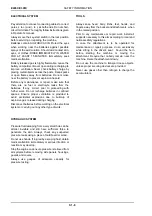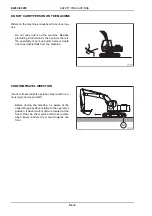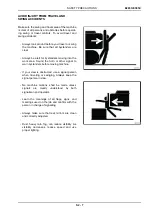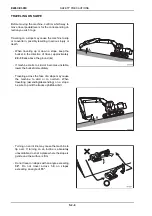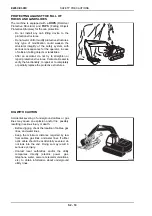
E265C-E305C
SAFETY INFORMATION
S1 - 6
to the end of the fuelling operation to avoid possible
generation of sparks due to static electricity.
Use a truck or trailer to haul a failed machine. Should
it be necessary to tow it, provide for suitable danger
signals as required by the local norms and
regulations and observe recommendations given in
the Operator's manual. Load/unload the machine on
firm level ground providing safe support to the wheels
of the truck or trailer. Use strong access ramps, with
adequate height and angle. Keep the trailer flatbed
free of mud, oil or slippery materials. Tie the machine
securely to the trailer and block carriages and
upperstructure.
Never align holes or slots using your fingers;
alwaysuse appropriate aligning tools.
Remove all sharp edges and burrs from re-worked
parts.
Use only approved and effectively grounded auxiliary
power sources for heaters, battery chargers, pumps
and similar equipment to reduce electrical shock
hazard.
Lift and handle heavy components using hoisting
devices of appropriate capacity. Ensure the parts are
supported by appropriate straps and hooks.
Use lifting eyes provided to this aim.
Pay attention to bystanders near the lifting area.
Never pour gasoline or diesel fuel into open
containers. Never use gasoline, solvents or other
flammable fluids to clean parts. Use proprietary
certified non-flammable, non-toxic solvents only.
When using compressed air to clean parts, wear
safety glasses with side shields. Limit pressure to
max 2 bar, in accordance with local and national
safety regulations in force.
Do not run the engine of this machine in closed
buildings without proper forced ventilation capable to
remove toxic exhaust gases concentrating in the air.
Do not use open flames as light sources to look for
leaks or inspect anywhere on the machine.
Make sure that all mechanical tools provided are in
good condition at all times. Never use tools with
mushroomed or damaged heads. Always wear eye
protections with side shields.
Move with extreme care when working under, on or
near the machine or its attachments.
In case of attachment tests during which the engine
should be kept running, a qualified operator must sit
in the driver’s seat at all times while the mechanic is
at work.
Keep hands and clothes far off moving parts.
Stop the engine and move the safey lever to the lock
position before starting adjusting or repairing an
assembly.
Do not carry out any work on the attachment without
prior authorisation. Observe maintenance and repair
procedures.
In case of field service, move the machine to level
ground and block it. If work on an incline cannot be
avoided, securely block the machine and its
attachments. Move the machine to level ground as
soon as possible.
Do not twist chains and cables. Never use a twisted
chain or cable for lifting or pulling. Always wear safety
gloves to handle chains or cables.
Be sure chains and cables are firmly fastened and
that the anchor point is strong enough to withstand
the expected load.
Keep all bystanders clear of the anchor point, cables
or chains. Do not pull or tow unless the operator’s
compartments of the machines involved are fitted
with proper guards against cable or chain backlash.
Keep the maintenance area clean and dry at all
times.
Clean immediately all water and oil spillage.
Do not pile up oily or greasy rags as they represent a
major fire hazard. Always store them in closed metal
containers.
Before starting the machine or its attachment, check,
adjust and lock the operator’s seat. Also ensure that
nobody is within the machine or attachment
operating range before starting or operating the
machine and/or its attachments.
Sound the horn.
Rust inhibitors are volatile and flammable.
Prepare parts in well ventilated areas. Keep open
flames away.
Do not smoke.
Store containers in a cool well ventilated place where
they could not be reached by unauthorised people.
Do not carry loose objects in your pockets that might
fall unnoticed into open compartments.
Wear appropriate safety clothing such as hard hat,
safety shoes and gloves, safety glasses when
splinters or other particles may be ejected.
Wear the appropriate welder’s equipment such as
dark safety glasses or mask, hard hat, protective
clothing, safety gloves and footwear always while
welding or arc-cutting. Wear dark safety glasses
when you are near a welding in progress.
Do not look the welding arc without proper eye
protection.
Become acquainted with all your jacking equipment
and their capacity.
Ensure that the jacking point on the machine is
appropriate for the load applied. Also, be sure the
supports under the jack and between the jack and the
machine are appropriate and stable.
Any equipment supported by a jack represents a
possible hazard. Always support the load onto
appropriate blocking means as a safety measure
before proceeding with service or maintenance work,

















